
Wrestling With a Mining Slump, Mongolia Plans for Its Next Boom
Four years ago, Mongolia’s vast mineral wealth prompted some to call it the “Saudi Arabia of Central Asia”. Today, the country is struggling with declining mineral revenues and inflation. In Mongolia natural resource revenue volatility is not an academic notion—it has led to real hardship for families and fear about the future.
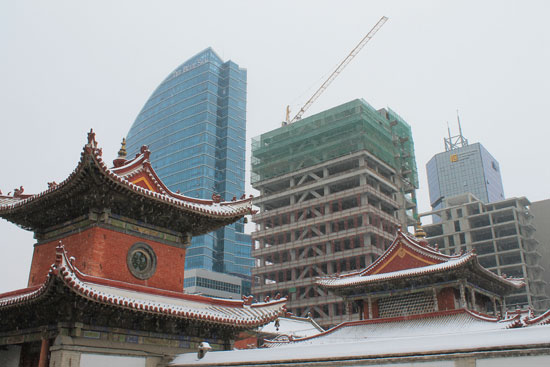
The effects of Mongolia's economic downturn are visible in the capital, with half-finished hotels and office buildings dotting the skyline. (Photo: Andrew Bauer)
Mongolia has enjoyed a decade of rapid economic growth fueled by large mining investments. Yet over the past two years, falling commodity prices, conflicts with local communities, and systematic cost overruns have squeezed the mining industry globally. In Mongolia, after cresting in 2011 and 2012, foreign direct investment fell by almost half in 2013, while falling demand from China all but halted coal exports. Now, a wave of uncertainty is sweeping the country like a chilly wind across the steppes.
“People in rural areas [outside of mining communities] are not suffering as much from the downturn, because they are reliant on meat or cashmere,” says parliamentary researcher Altan-Och Genden. “But government officers and the people in the urban areas feel the consequences,” he adds, noting that private enterprises are also suffering negative impacts.
Those whose livelihoods depend on mining have also been hit hard. Approximately 14,600 people were employed at Oyu Tolgoi, the massive copper mine bordering the Gobi Desert, during the first phase of development. As development of the mine has slowed, employment has shrunk to fewer than 7,000 people.
“With commodity prices down, former mine workers can’t find other well-paying mining jobs,” says Bayarsaikhan Namsrai, Mongolia’s Publish What You Pay coordinator. “So they must now take less money. In the soums [municipalities], shops are bringing in less revenue.”
Even the casual visitor can see the effects of the downturn in the capital. The skyline is dotted with high-rise cement skeletons, mostly hotels and office buildings where construction stopped once demand dried up. The local currency, the tugrug, has also depreciated significantly over the last year and a half. As a result, food, clothing and construction materials—mostly Chinese imports—now cost much more.
The Mongolian government faces tough choices
With copper prices expected to rebound by 2016, the current slump should be temporary. Economic theory suggests that in an uncertain environment, the best possible response to a temporary negative revenue shock is for the government to sustain or even increase spending, which is exactly what Mongolia’s government has done.
Unfortunately that level of spending is unsustainable over the long term. The fiscal deficit, including off-budget items like the national development bank, exceeds 12 percent of GDP. Public debt is growing quickly, breaking Mongolia’s own fiscal rules. The IMF is already pressuring the government and the central bank to tighten both fiscal and monetary policies.
In the short-term, the government can cut spending, or it can raise the debt ceiling and borrow until mining investment rebounds. The ministry of finance tried to raise the ceiling last year and was blocked by parliament. It may try again. Alternatively, the central bank can accept a Chinese bailout and pump money into the economy by purchasing assets or taking on projects normally administered by the government, like subsidizing residential mortgages. A ready patron for this mineral-rich country, the People’s Bank of China recently provided a $3.25 billion line of credit to the Mongolian central bank.
None of these options is ideal. Cuts in spending would weaken growth, cause unemployment and potentially harm the country’s long-term prospects. Debt increases could eventually lead to higher interest rates and a debt crisis. A Chinese bailout would result in further dependence for a government already squeezed geographically and politically by two superpowers.
Authorities consider the mineral-dependent economy
Mongolian policymakers are fast learning that managing an oil- or mineral-rich economy is quite different than managing an economy as though it were based on services or manufacturing. Had the government followed a fiscal rule that smoothed expenditures and required saving windfall revenues in a stabilization fund, Mongolia’s outlook would be much rosier today. Instead, it spent much of these revenues on petroleum reserves, which depreciate quickly, and on agricultural reserves and cash handouts.
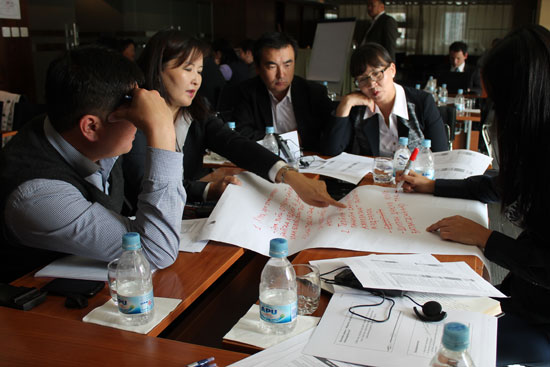
Parliamentary staff discuss international "good practices" for improving natural resource governance. (Photo: Andrew Bauer)
“[Poorer] people depended on the cash transfers,” says PWYP’s Bayarsaikhan Namsrai, speaking of the 21,000 tugrug, or $14, per person per month payments that ended in 2012. “It raised many expectations. For these families, it’s hard to adjust. Since the cash transfer was stopped, local governments have been filled with applications for social benefit support.”
Altan-Och Genden blames the relatively new challenge of managing large mineral revenues. “The key point is that Mongolia is a large country with a small population,” he says. “Mineral revenues are huge on a per person basis and as a percentage of GDP. Mongolians have no experience in managing, spending or using such big amounts of money.”
He also points to the country’s nomadic lifestyle, which he says has made adjusting to an advanced market economy challenging. “Development is seen as a shift from a nomadic lifestyle to a settled lifestyle,” he says. “Peoples’ mentality is mainly nomadic, so in Mongolia it’s a new challenge to innovate. But we want to use international best practices.”
Plans for a new sovereign wealth fund take shape
Many believe that one of these “best practices” is to create a new sovereign wealth fund. In a draft bill, the president has called for a corporation that would save more than 20 percent of mineral revenues in any given year for the benefit of future generations. This “Future Heritage Fund” would absorb an existing (and significantly indebted) fund for cash transfers.
There is great debate about whether this fund would be appropriate in Mongolia. Some ask why the government should invest revenues in foreign assets, as sovereign wealth funds do, when spending on well-trained teachers and infrastructure is urgently needed?
“Some money needs to be saved so that future generations can benefit from these finite resources,” says Borgil Surenkuu, an advisor to the working group drafting the sovereign wealth fund law. “Also, the government has limited absorptive capacity to spend. If it spends too much too quickly, the money will be wasted or cause inflation.”
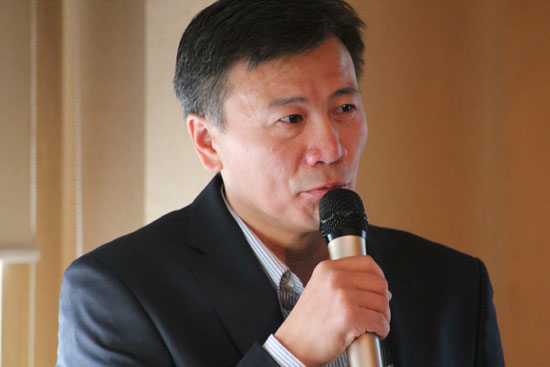
Borgil Surenkuu, parliamentary advisor (Photo: Andrew Bauer)
Another question concerns interest rates. Should the government invest mineral revenues in foreign assets when the returns are likely to range from 3 to 6 percent and the government is borrowing at 5 to 8 percent? Ghana faces this exact challenge at the moment. A sovereign wealth fund may only make sense if the economy improves and sovereign bond yields come down.
Like many in the government, Altan-Och Genden is a proponent of a fund: “I’ve made some studies about the challenges of managing mineral revenues for Mongolia. A sovereign wealth fund is the only solution to these challenges.”
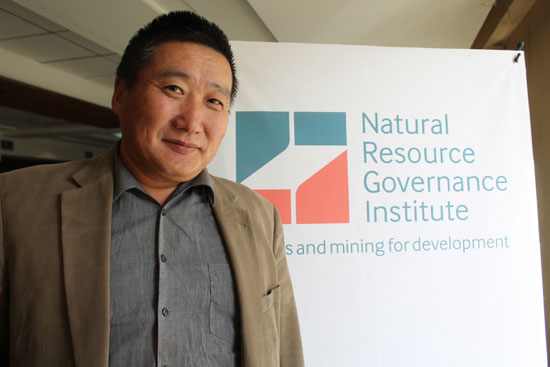
Altan-Och Genden, principle officer at the State Great Hural (Parliament) Research Centre (Photo: Femke Brouwer)
Parliamentary staff prepare for debate
The sovereign wealth fund legislation could be tabled in parliament within the year. In preparation for this and other debates, more than 30 parliamentary staff attended a training with the Natural Resource Governance Institute (NRGI) to learn how to manage the nation’s mineral windfalls. They also studied existing mineral contracts to project future mineral revenues, which is key to assessing how much Mongolia should save in the proposed sovereign wealth fund.
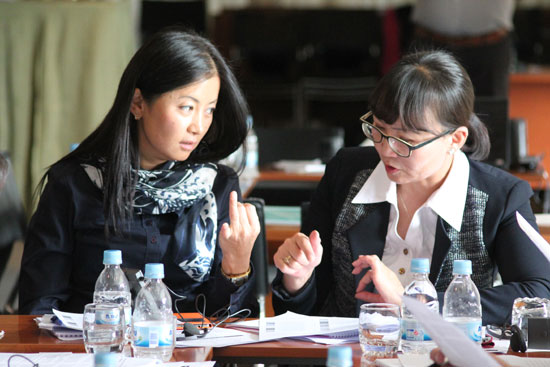
At an NRGI training, policymakers discuss the merits and drawbacks of saving mineral revenues in foreign assets. (Photo: Andrew Bauer)
After the training, participants like Altan-Och Genden expressed their readiness to engage in the policy-making process. “Now that the draft law on the Future Heritage Fund has been submitted, we will give our inputs into the draft law process,” he said.
Going forward, internal political pressures—along with pressures from mining companies, foreign governments and international institutions—may induce the government to quickly cut spending, consume mineral revenues rather than invest them, or establish laws that are not suited to a mineral-dependent country. Yet Mongolia has transformed many of its mistakes—and those of other countries— into lessons. There is good reason to believe that the next revenue windfall will be better managed than the last.
Andrew Bauer is an economic analyst at NRGI.
Recently Mongolian parliamentarians visited Western Canada to learn about mining booms and busts. Two of them spoke with NRGI about what they learned. Read more »
